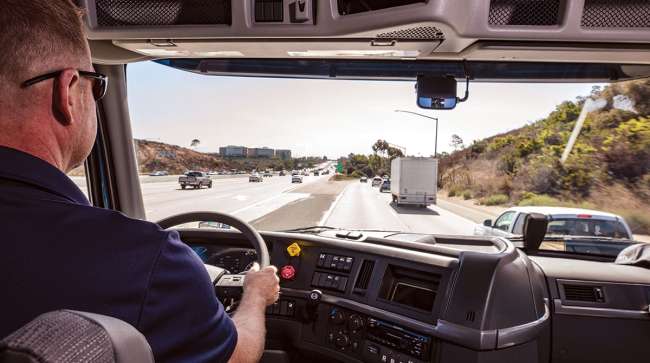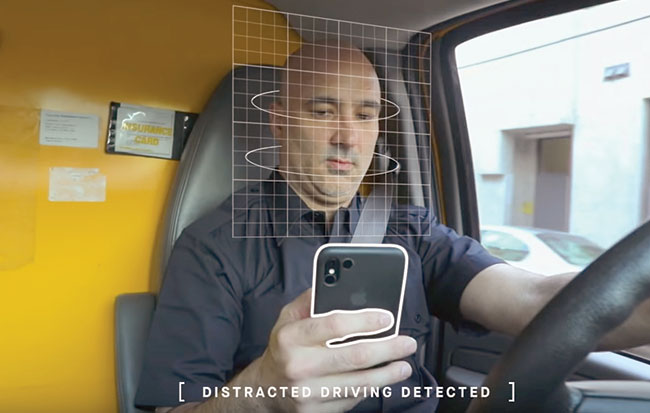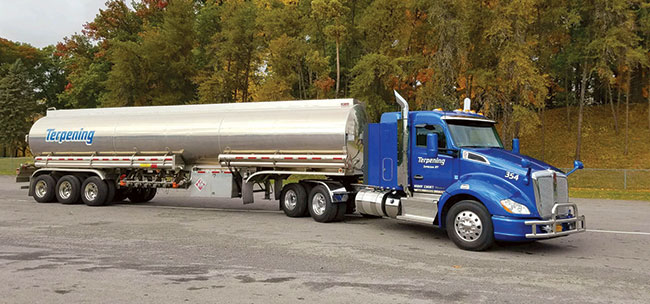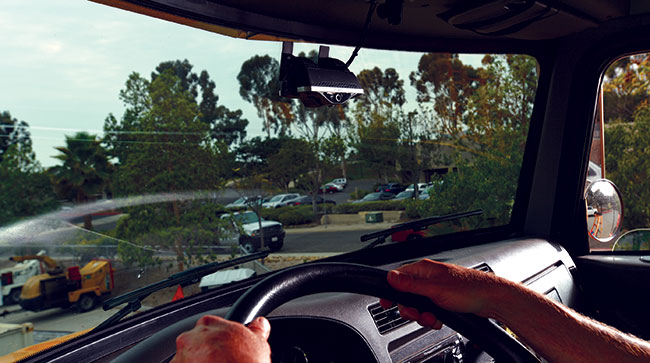Fleets Turn to In-Cab Driver Coaching to Boost Safety Through Instant Feedback

[Stay on top of transportation news: Get TTNews in your inbox.]
With the latest advances in onboard video and artificial intelligence, more fleets are implementing in-cab driver coaching to help reinforce safe driving habits, prevent crashes and enhance drivers’ overall performance.
Motor carriers and technology vendors said providing drivers with immediate feedback on their performance can enable a more proactive stance on safety, but also acknowledged that gaining driver acceptance of cameras and related technologies can sometimes be a challenge.
David Serach, safety director at oil field trucking company Chalk Mountain Services, said the carrier worked to assure its drivers that the system it was considering was not a threat.
The Fort Worth, Texas-based company, which hauls sand to hydraulic fracturing sites in south and west Texas, operates a fleet of about 275 tractors and 900 bulk tank trailers and employs about 500 drivers.
“We incorporated drivers into the trial to get their feedback — what they liked, what they didn’t like about the system,” Serach said.
Some drivers initially were wary of the technology, assuming that the alerts meant they were in trouble. But Serach said the drivers were advised that an in-cab alert did not automatically mean a mark against their driving, nor did it mean that they would automatically be summoned for in-person coaching.
“We wanted to be very clear and transparent with the drivers, up front,” he said. “We were not installing a ‘gotcha’ system.”
After a trial period of about nine months, the company decided to implement the system, provided by Samsara, that includes inward- and outward-facing cameras and alerts for speeding, following too closely and distracted driving.
Fleetwide implementation was completed in February 2021. Even though the system wasn’t in place for all of that year, it still yielded dramatic safety improvements over the year before, Serach said.
The company in 2021 recorded an 86% decrease in preventable accident costs and a 43% decrease in workers’ compensation costs compared with the previous year, Serach said.

Some fleet are using onboard cameras to prevent unsafe behaviors such as distracted driving. (Samsara via YouTube)
Since the implementation, Chalk Mountain’s trucks have traveled more than 30 million miles without “a DOT-reportable, preventable accident,” he said.
Serach said that by working with drivers to improve their driving behavior, the company was maintaining the fleet’s “safety culture,” which in turn helped the carrier improve driver retention by 15%.
Samsara is preparing to release a new safety feature to its customers that will allow drivers the opportunity to “self-correct” risky behavior after receiving an in-cab alert.
Ingo Wiegand, senior director of product management for Samsara, said safety managers using the feature, called In-Cab Nudges, will be able to control how many in-cab alerts can be triggered.
Once the number of alerts is exceeded, the system registers that information on the carrier’s Samsara dashboard, notifying management of the need for coaching, Wiegand said. For managers, the system will save time on alert reviews and enable them to focus on addressing the riskiest driving habits, Wiegand said.
Terpening Trucking uses onboard cameras in conjunction with a system that issues audible prompts to drivers to encourage “progressive shifting” said Brian Brundige, vice president of operations for fuels and dry bulk freight at the Syracuse, N.Y.-based fleet.
The carrier, which operates 165 trucks, uses a software application from Vnomics in conjunction with Lytx and Samsara onboard cameras.
“I’m a big fan of coaching drivers,” Brundige said.

Terpening Trucking has installed in-cab technology to coach drivers and encourage progressive shifting to save fuel. (Terpening Trucking)
In progressive shifting, drivers shift in a lower RPM range to save fuel, he said. The Vnomics product True Fuel emits a tone if a driver doesn’t make the shift within the defined RPM range, Brundige said.
“If they don’t want to hear it, they shift sooner, at a lower RPM,” he said.
Before implementing Vnomics, the fleet’s average miles per gallon was 5.2, Brundige said. With the technology in use, the average mpgincreased to 5.8.
The carrier transports petroleum products, biodiesel and cement. Loads are usually 102,000 or 107,000 lbs.
“We haul heavy,” Brundige said.
The carrier has used the technology for years, Brundige said, and he noted that the average mpg “fluctuates a little bit.”
“We have 160-plus drivers. You can’t force a driver to progressive shift, but it’s strongly recommended and encouraged and we train on it. But we don’t punish a driver if he doesn’t achieve that [fuel mileage],” he said. “They’re free to drive the truck how they will.”
Speed alerts are another feature of the Vnomics system that Terpening Trucking uses to coach drivers and save fuel.
In an analysis of fuel efficiency, Brundige said, the carrier learned that its trucks traveling at 68 miles per hour average 5.4 miles per gallon. At a slower speed of 64.5 miles per hour, average miles per gallon increases to 5.8, Brundige said. Accordingly, if a truck exceeds 69 miles per hour on-highway, the system emits a tone alerting the driver, Brundige said.
Ethan Sweeney, Vnomics’ director of customer success, said the company’s True Fuel product can yield improvements in fuel economy of 3% to as much as 10%. Tenstreet, a driver recruitment and retention software platform, announced in April that it acquired Vnomics.
In March, Trimble Transportation announced an integration with Vnomics. True Fuel will be offered to fleets using Trimble in-cab technology.

There are many reasons for trucking's ongoing labor shortage. We recap discussions from the first half of this year in this "roundabout" episode. Tune in above or by going to RoadSigns.TTNews.com.
Jesse Chappell, global business development manager at Trimble Transportation, noted that many safe driving practices mirror fuel-saving driving techniques. These include proper following distance and minimizing sudden stops and rapid starts.
“Those are all things that lead to higher [fuel] efficiency,” he said.
Chappell, who oversees Trimble’s Video Intelligence solution, said onboard video originally was adopted by much of the heavy-truck market as an “exoneration tool.”
If a driver had an accident, video was used to try to prove or assist in proving that the driver was not at fault, or that the driver did everything they could to avoid an accident, Chappell said.
The incorporation of artificial intelligence spurred development of driver alerts, he said, noting that Trimble’s system includes the ability to monitor for fatigue or distracted driving, cell phone usage and smoking.
Chappell recounted visiting a fleet where a safety manager showed a video of a driver at the end of his shift who could be seen following just a little too closely.
Seeing “little things like that gives [drivers] an awareness of their behavior,” he said, adding, “It’s not always the catastrophic things that you need to coach on. It’s the little things that lead up to it.”
With the return of some workers to their workplaces, the National Highway Traffic Safety Administration reported a rise in highway fatalities, with some related to distracted driving, said Gary Johnson, director of safety services for Lytx.
Lytx’s DriveCam event recorders use machine vision and artificial intelligence technology that can help address distracted driving and detect risky driving.
“We’ve focused on enhancements in the driver app experience” to address distracted driving especially, Johnson said.
It registers an action such as a driver picking up a cell phone, and if the driver doesn’t respond to a prompt and put down the phone — fails to make a “self-correction” — the system will seek a correction through the driver app, Johnson said.
“It’s immediate,” he added. “Instead of a reaction in 24 to 48 hours for a coaching moment, it’s seeking it now.”
Netradyne, another video-based safety system provider, this summer introduced its Driver-iHub X, a device that enables customers to add up to four external cameras to their existing installation for a 360-degree view around the vehicle, the company said in an announcement. The company also announced enhancements and new features to its vision-based safety platform.

In-cab alerts provide drivers with more immediate feedback on their driving performance. (Netradyne)
In-cab coaching is also a key focus for product development at trucking technology supplier Solera, the parent of telematics company Omnitracs, the video-based safety provider SmartDrive, and eDrive, a digital driver risk management tool for commercial fleets.
“Systems that provide real-time feedback still rely on the driver to interpret a situation and determine what actions they need to take,” said Jason Palmer, vice president of global product operations and strategy for Solera. “What they don’t do is provide the overarching driver skills training that is part of a more comprehensive program.”
Such a program can reduce collision frequency, and that, Palmer said, is “the ultimate goal.”
Collisions, such as those that happen while merging in traffic, can be complex, influenced not only by driving skills, but by other vehicles and weather conditions, Palmer said.
Solera’s driving analysts use the information collected by its technologies to determine whether the driver is merging safely or is in need of training, he said. If there’s a training need, Solera creates a skills-training video for the driver to review on a mobile app. For drivers who are repeat cases, Solera provides a training module.
Want more news? Listen to today's daily briefing below or go here for more info:

